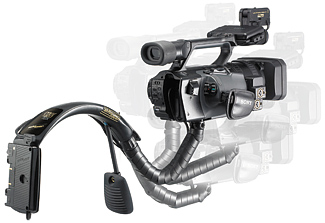Anton Bauer Stasis Flex

The Anton/Bauer Stasis Flex camera support Anton Bauer has developed a new stabilization device called the Stasis Flex. Using your shoulder as support, the Stasis Flex permits the camera to be handheld, but operated within a stabilized environment.
FEATURES
The Anton/Bauer Stasis Flex somewhat resembles a snake with a flat tail. It provides a level head for supporting the user's camera. The unit is designed to work with Anton/Bauer Gold Mount brick batteries in the rear (to help distribute weight), and it has the company's EgripZ mount for supporting cameras weighing more than four pounds. There's also an adjustable chest pad that plants itself firmly against your sternum, and which is adjusted with a supplied Allen wrench. The arm may also be removed with a hacksaw and the pad re-attached if comfort requires it, but I'll comment more on this later.
The "Flex" arm has numerous "knuckles" that remain loose until the locking lever on the top is pulled to make the shape rigid. This is also adjustable, allowing for variations in the unit's operators. While such adjustments do take a few extra minutes, the instruction manual spells out the procedure very clearly. It's necessary to mount the camera to the plate in the front, then release the locking lever of the flex arm, and while supporting the camera, adjust the arm until the camera is at the correct height. That's all there is to it. The Stasis Flex can support cameras up to 14 pounds, but you really should use the EgripZ mount with units at the heavy end of the weight spectrum.
IN USE
A young woman in our summer program here at the university was selected to be first to try out this rather different camera mount. However, once the Stasis Flex was mounted, she found it quite uncomfortable, as the chest pad dug into her chest. The device's instruction manual states that you can cut it with a hacksaw—but it wouldn't grow back for other users. On the other hand, all of the male camera operators who used it had no problem with the chest pad, probably because they're designed differently than women. Other female volunteers had the same complaint with the Stasis Flex and would have preferred having the chest strap in the middle; however, that too would have been awkward for balance.
Fast FactsApplication
Shooting jobs requiring a stabilized camera support.
Key Features
Adjustable arm, good weight distribution, moveable chest pad and is adaptable to most cameras
Price
MSRP as tested, $280
Contact
Anton/Bauer Inc. | 800-422-3473 | www.antonbauer.comWith the knowledge that our Stasis Flex was gender-friendly only to the males, we used it for the next week with very little variation in adjustments with users ranging from 5-feet, 5-inches to 6-feet, 4-inches—one size does fit all (if you're a male). Each user found that it did relieve the stress of continuous handheld shots, but found that he had to remove the camera when dismounting. The release plate is fast enough, but is slightly difficult to activate while wearing the apparatus.
When I finally got a chance to use it, I enjoyed having the strain removed from my forearm when hefting a camera for three hours. Unlike most stabilization mechanisms, you do not need a "get acclimated" period. Right out of the box you can wear it for extended periods of time without sore muscles.
SUMMARY
The Statis Flex certainly is a labor saving device; however, females may find that they could have a difficult time wearing it for longer duration shoots. On the other hand, male users will find it a lot easier wearing the Statis Flex all day to help overcome the fatigue of handholding a camera. I believe it to be a worthwhile investment if a typical day consists of shooting for extended periods of time where the shooter is constantly on the move and can't use a conventional camera mounting platform.
Chuck Gloman is the program director of the TV/Film department at DeSales University. He may be contacted atchuck.gloman@desales.edu.
Get the TV Tech Newsletter
The professional video industry's #1 source for news, trends and product and tech information. Sign up below.
Chuck Gloman is Associate Professor with the TV/Film Department at DeSales University.

